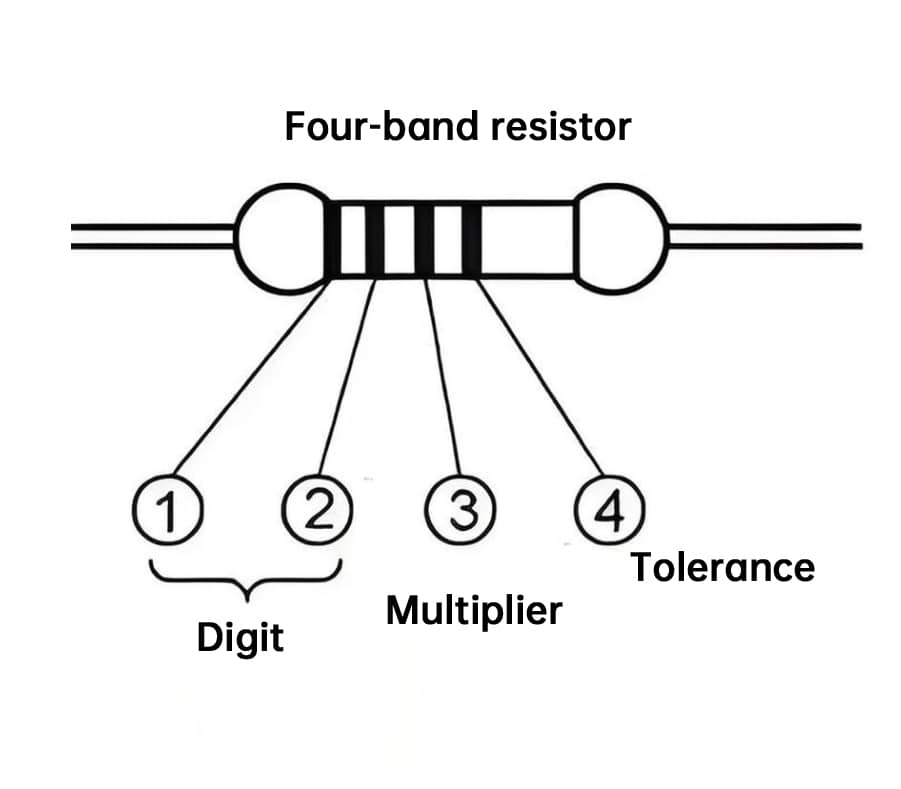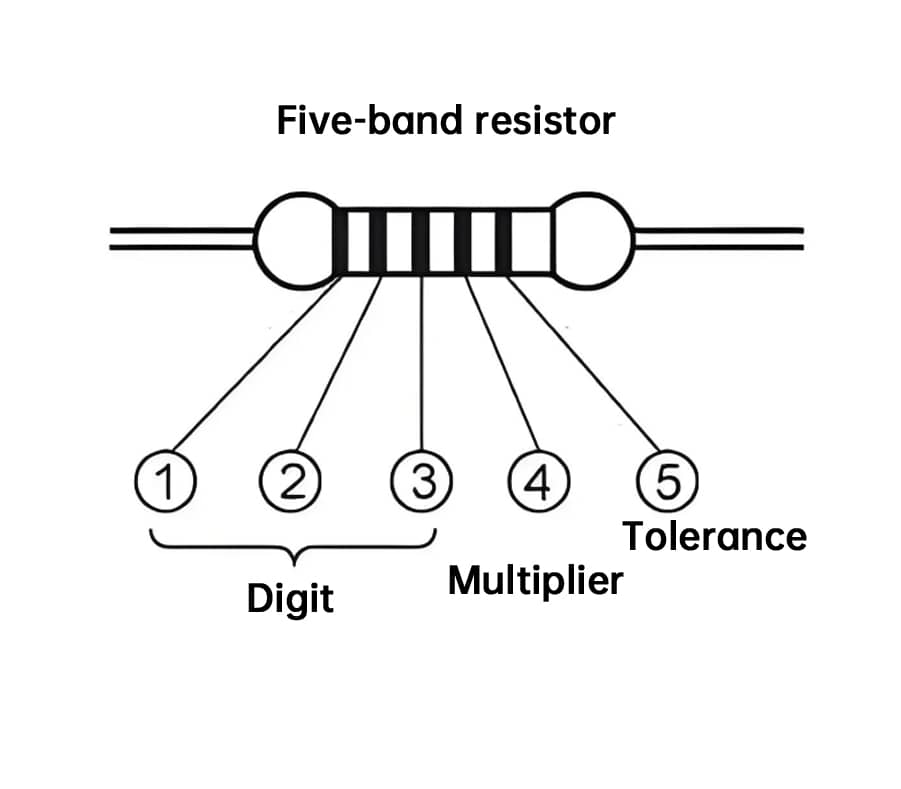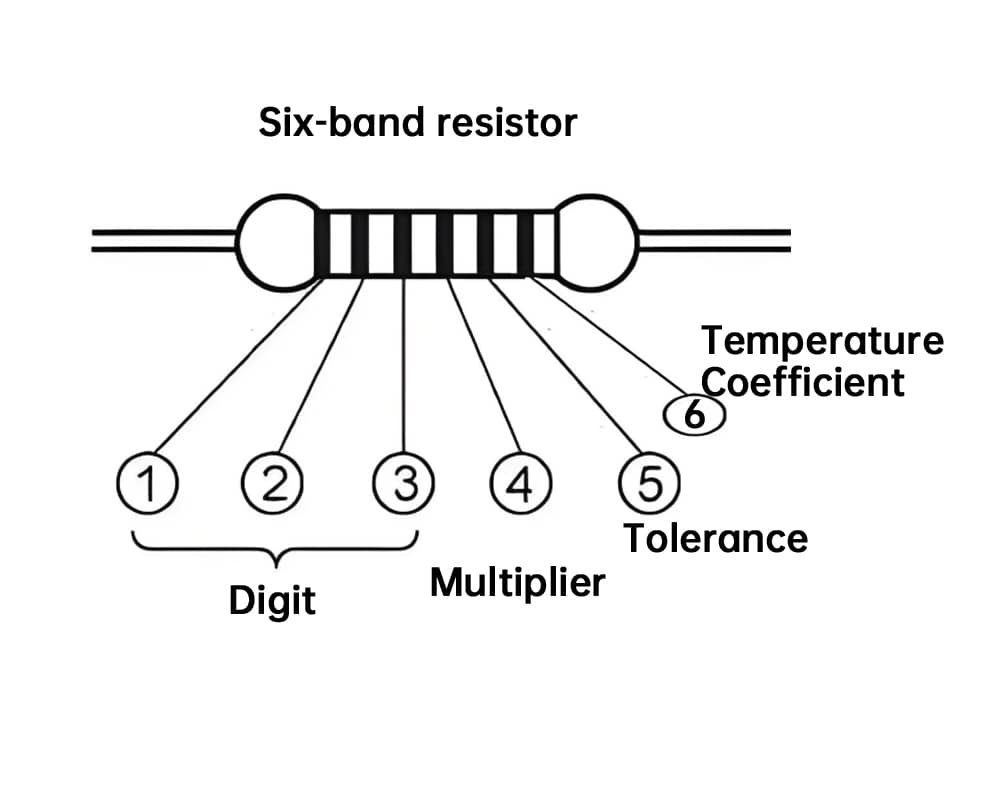Resistor Color Code Basic Knowledge
What is a Resistor Color Code?
The resistor color code is a method of indicating the resistance value using colored stripes, commonly found on axial resistors. You can think of it as the "ID card" of a resistor, where each colored band represents a specific number or coefficient. The clever combination of these colors indicates different resistance values and their tolerance range.
Color band resistors have colored stripes painted on their surface to represent their resistance value. There are three-band, four-band, five-band, and six-band resistors, with three-band and six-band being less common. The four-band and five-band types are the most common. Color band resistors are still widely used in electronic circuits, such as in household appliances, electronic instruments, and devices. Being able to quickly and accurately read the values of color band resistors is an essential skill in the field.
Color Bands Composition
There are several configurations for color bands:
-
Four-band: Indicates resistance value and tolerance, commonly used for standard resistors.
-
Five-band: Used for higher precision resistors, adding an extra significant digit.
-
Six-band: Builds on the five-band configuration by adding a color band for “temperature coefficient.”
Color - Digit Mapping
The correspondence between colors and numbers is as follows: Black: 0, Brown: 1, Red: 2, Orange: 3, Yellow: 4, Green: 5, Blue: 6, Violet: 7, Gray: 8, White: 9. Gold and silver do not have numerical values; they are primarily used to indicate tolerance.
The following chart shows the relationship between color, digit, multiplier, tolerance and temperature coefficient:
|
Color |
Digit |
Multiplier |
Tolerance (%) |
Temp. Coeff. (ppm/°C) |
|
Black |
0 |
10⁰=1 |
- |
- |
|
Brown |
1 |
10¹=10 |
±1 |
100 |
|
Red |
2 |
10²=100 |
±2 |
50 |
|
Orange |
3 |
10³=1K |
- |
15 |
|
Yellow |
4 |
10⁴=10K |
- |
25 |
|
Green |
5 |
10⁵=100K |
±0.5 |
20 |
|
Blue |
6 |
10⁶=1M |
±0.25 |
10 |
|
Violet |
7 |
10⁷=10M |
±0.1 |
5 |
|
Gray |
8 |
10⁸=100M |
±0.05 |
1 |
|
White |
9 |
10⁹=1G |
- |
- |
|
Gold |
- |
10⁻¹=0.1 |
±5 |
- |
|
Silver |
- |
10⁻²=0.01 |
±10 |
- |
Note: Tolerance and temperature coefficient bands appear only in 5-band or 6-band resistors.
If you need to identify resistor color codes frequently, it is recommended to use the online resistor color code calculator from Digikey.
How to Quickly Identify Resistor Color Codes
How to Read Four-band Resistors
Four-band resistors are the most common type of color band resistors, widely used in consumer electronics and basic circuit design. Their structure is as follows:

Decoding Steps:
-
Orientation: The tolerance band (gold/silver) is usually on the right.
-
Digits: First two bands form a 2-digit number.
-
Multiplier: Third band sets the order of magnitude.
-
Tolerance: Fourth band indicates allowable deviation.
For Examples:
-
Yellow (4) - Violet (7) - Red (×100) - Gold (±5%) = 47 × 100Ω = 4.7kΩ ±5%
-
Red (2) - Red (2) - Brown (×10) - Silver (±10%) = 22 × 10Ω = 220Ω ±10%
-
Blue (6) - Gray (8) - Gold (×0.1) - Gold (±5%) = 68 × 0.1Ω = 6.8Ω ±5%
How to Read Five-band Resistors
Five-band resistors are primarily used in precision electronic devices, measuring instruments, and high-accuracy circuits. They add an extra significant digit, significantly improving resistance accuracy:

Identification Features:
-
The first three bands represent three significant digits, with accuracy improved by one order of magnitude compared to four-band resistors.
-
The fifth band indicates tolerance, typically brown (±1%), red (±2%), or green (±0.5%).
-
The fourth band may be gold or silver, indicating a decimal point shift.
Five-band Resistors Examples:
-
Brown (1) - Green (5) - Black (0) - Red (×100) - Brown (±1%) =150 × 100Ω = 15kΩ ±1%
-
Yellow (4) - Violet (7) - Black (0) - Gold (×0.1) - Red (±2%) = 470 × 0.1Ω = 47Ω ±2%
-
Green (5) - Blue (6) - Black (0) - Black (×1) - Brown (±1%) = 560 × 1Ω = 560Ω ±1%
How to Read Six-band Resistors
Six-band resistors build on the five-band configuration by adding a temperature coefficient indicator. They are used in specialized fields where temperature stability is critically important:

Temperature Coefficient Explanation:
-
Indicates the change in resistance value in parts per million (ppm) for every 1°C change in temperature.
-
Brown: 100 ppm/°C
-
Red: 50 ppm/°C
-
Orange: 15 ppm/°C
-
Yellow: 25 ppm/°C
-
Blue: 10 ppm/°C
-
Application Example:
Brown (1) - Red (2) - Blue (6) - Orange (×1K) - Brown (±1%) - Blue (10ppm) = 126 × 1,000Ω = 126kΩ ±1%, temperature coefficient 10ppm/°C.
Resistor Color Code Mistakes: How to Avoid Common Errors
-
Color Confusion: Production batch and process differences can lead to color deviations, especially between green and blue, or brown and red in low light.
Solution: Use white LED light for better observation; verify uncertain resistors with a multimeter. -
Direction Misreading: Incorrectly reading the order can result in a hundredfold value discrepancy. For example, gold-black-red-brown misread as 2kΩ instead of the correct 12Ω (brown-red-black-gold = 12 × 1Ω).
tips: Remember that "gold and silver bands are never the first band." -
Package Type Confusion: Surface mount resistors use three-digit or four-digit codes instead of color bands (e.g., "103" means 10 × 10³Ω = 10kΩ). Mixing identification rules can lead to completely wrong results.
-
Ignoring Special Rules for Five and Six Bands: In five-band resistors, a gold fourth band indicates ×0.1, not tolerance; the temperature coefficient band in six-band resistors is often overlooked.
Recommendation: For precision circuits, ensure all color band meanings are confirmed.
Resistor Reading Hacks: Avoid Common Mistakes!
By mastering these Resistor Color Code rules, you can quickly identify the parameters of most resistors. In practical applications, it’s recommended to verify with a multimeter to avoid misreading due to color fading or contamination.
Conclusion: Your Resistor Reading Mastered
Reading resistor color bands is not only a fundamental skill for electronic engineers but also an essential capability for circuit analysis and repair. By understanding the meanings of color bands, employing quick identification techniques, and recognizing common pitfalls, you can significantly improve work efficiency and accuracy.
It is recommended to frequently use mnemonics and practice measurements for reinforcement. This will help transition from merely "seeing colors to identify values" to making "precise judgments."

Comment